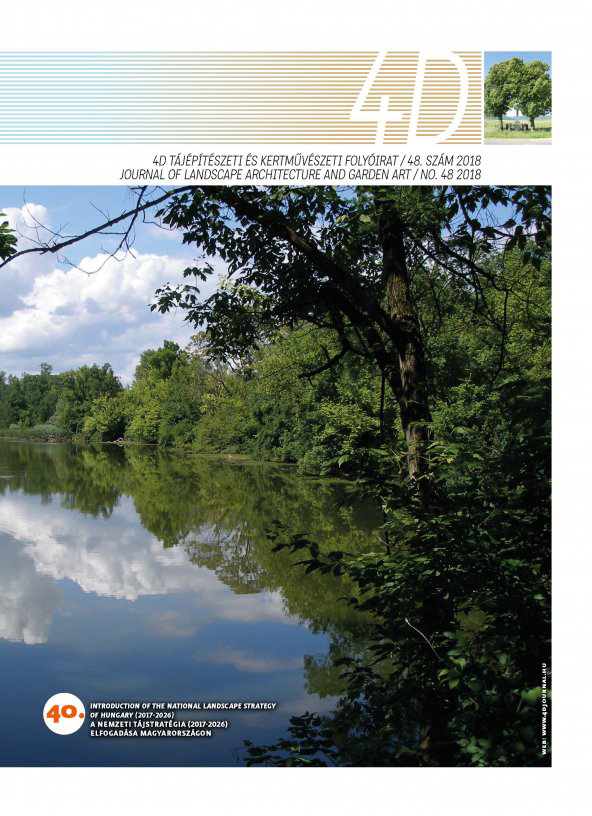From landscape character to urban image; transformation of vineyards in the old Buda regions
Keywords:
urban image, landscape character, urban vineyards, landscape history, building character, Buda, Buda hills, Buda villas, green surfaces of Buda, landscape changeAbstract
Buda hills — considered as a live-able urban environment and attractive living space — has been formed on site of former vineyards. Similar area changes have occurred in different European capitals too, but, in terms of viticulture, corresponding terri- tories have been occupied by urban landscape in a different manner. The primary focus of our study was to identify the building blocks of the Buda facade and its background.
This paper intends to analyse the land-scape/urban transformation Buda vineyards has undergone since the last decades of the 19th century. The changes were analysed at the same territory using identical point of views. The study
- by exploring the phases and driving forces of changes in urban growth and plant cover — intends to present the preserved characteristics and landscape elements of viticulture. Landscape approach of people at all times is pictured through the inconstant ways and tools of searching for landscape The results show, that, in terms of Buda, the civil villas and estate centres of hill estates could be identified as the archetype of the subse- quent urban growth character. The gradual urban growth followed by the phylloxera plague is equally attributed to the constant residential needs and to the inner market crisis of viniculture.
The significant number of trees has a beneficial effect on urban character and a harmonising impact on architectural diversity. On the contrary, today, the same trees rather obstruct the visual connections from the higher parks and lookouts. According to the uniform landscape/urban character of Hegyvidék — divided into districts in terms of public administration —, its similar development history, as well as its values and problems, a capital zone levelled image regulation is needed.
References
Károly Keleti: Magyarország szőlészeti statisztikája 1860–1873. Bp., 1875
Boromisza, Zs., Csima, P., Dublinszki- Boda, B., Módosné Bugyi, I. (2011): Landscape character assessment met-hodology applied for specific landscape types in Hungary. The Problems of Landscape Ecology. Vol. XXX. pp. 233- 240.
Csima, P. (2012): Tájvédelmi célú tájkarakter elemzések rurális tájban. (Landscape character analyses in rural landscape with a focus on landscape pro- tection) pp. 51-63. In. Farsang A.; Mucsi L.; Keveiné Bárány I. (szerk.): Táj - érték, lépték, változás. Geolitera, Szeged.
Aicher, F., Caviezel, N., Eisel, U., Froh- mann, E., Kirchengast, A., Körner, S., Weber, A. (2016): Landschaft und Lebens- sinn., 144, Müry Salzmann Verlag, Salz- burg-Wien.
Meggyesi, T. (2008): Települési kultú- ráink, Terc.
Szilágyi, K: (2001): Jókai tündérkertje. In: Kalla, Zsuzsa(ed.): Gyümölcsfák, rózsák, regények – Jókai Mór és a Sváb- hegy. Petőfi Irodalmi Múzeum, Budapest. 27-33. p.
Siklóssy, L. (1931): Hogyan épült Budapest? (Published by the Council of Metropolitan Public Works, in 1931, reprinted in 1985.)
Simon, M. (2002): „A hegyekben élő mesebeli óriások”, in: Architectura Hun- gariae, 4 (2).
Budapest Főváros településszerkezeti terve 2015, 1:10000
http://mindennapoktortenete.blog. hu/2014/04/04/psziches_betegsegek_ tortenete
http://www.janoskorhaz.hu/tortenet/
https://www.weingueter-in.de/ oesterreich/weinanbaugebiete/wien/
Downloads
Published
Issue
Section
License
Copyright (c) 2024 Zsuzsanna Illyés, Zsófia Földi, Eszter Jákli, László Nádasy

This work is licensed under a Creative Commons Attribution-NonCommercial-NoDerivatives 4.0 International License.
A folyóirat Open Access (Gold). Cikkeire a Creative Commons 4.0 standard licenc alábbi típusa vonatkozik: CC-BY-NC-ND-4.0. Ennek értelmében a mű szabadon másolható, terjeszthető, bemutatható és előadható, azonban nem használható fel kereskedelmi célokra (NC), továbbá nem módosítható és nem készíthető belőle átdolgozás, származékos mű (ND). A licenc alapján a szerző vagy a jogosult által meghatározott módon fel kell tüntetni a szerző nevét és a szerzői mű címét (BY).



